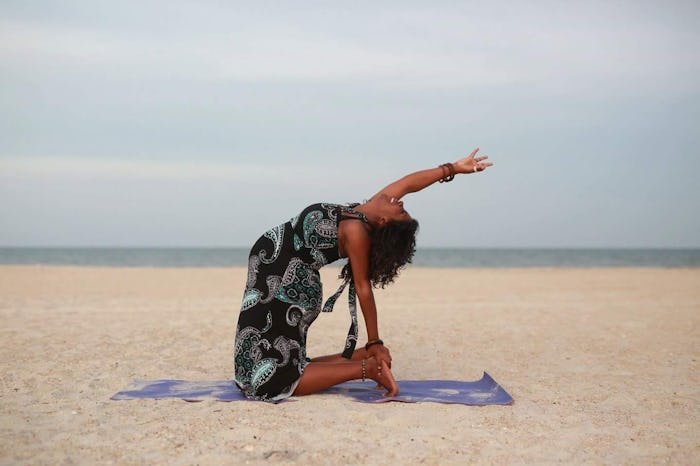Life

What You Need To Know About Prenatal Yoga, According To A Professional Yogi
You probably know that it's important to try to stay physically active while you're pregnant as it helps make your labor a little easier and keeps other parts of your body in shape during pregnancy. But for those who think running is the most horrible thing on the planet (me), and would like to do something a bit more low-key while still being healthy and practicing strength training (especially while pregnant), there's always yoga. But what about during pregnancy? What is the difference between prenatal yoga and regular yoga?
Ari Loggins knows the benefits of prenatal yoga as a teacher and as a student. She has been teaching yoga for seven years, started off getting certified in prenatal yoga and kids yoga, and then began to get into hatha yoga for adults. After having her own child (and doing prenatal yoga herself) she submerged herself back into kids and prenatal yoga.
“The difference between prenatal and regular yoga is very slim. In both types of yoga, you are practicing for your wellbeing, you are listening to your body, and becoming more aware of the realm you are physically and mentally in versus where you would like to take the boundaries of self. In both types, you are exploring flexibility, a sense of openness, and breath,” she says in an email interview with Romper.
Regular yoga positions that aren’t safe for pregnant ladies include poses that directly compress your belly, such as forward bends and twists. But that’s where the prenatal modifications come in, which include balancing poses. “I never teach poses to prenatal women directly lying on their backs because personally, it was uncomfortable for me, and they shorten your breath.” The modifications and props that support your “new limitations” as a pregnant woman support in “keeping your body in a safe place for movement, stillness, and the fine line of using isometrics to strengthen and relax your body at the same time,” Loggins explains.
According to Mayo Clinic, isometrics are “contractions of a particular muscle or group of muscles. During isometric exercises, the muscle doesn’t noticeably change length and the affected joint doesn’t move.” They don’t necessarily build strength, but they maintain your muscle strength, the Mayo Clinic noted. The exercises are done in one position without moving. “They can be useful in enhancing stabilization," which seems like a good thing to have before you go into labor.
Prenatal yoga definitely keeps you strong for labor, Loggins says. “When you are pregnant, some parts of you turn to mush, other parts cramp, other parts get tight. I always felt so loosened, relaxed, and completely at ease after practicing yoga in the evenings. It helped keep my back strong. Your center of gravity is also completely altered. It definitely helps with keeping your core engaged and fine tuning your balance." However, if you weren’t physically active prior to pregnancy, Loggins suggests you proceed going into a new yoga practice — prenatal or regular — with caution.
Loggins also mentions other benefits that aren’t necessarily physical. “I believe the peace that I had through pregnancy was ultimately the best benefit for consistently practicing yoga. I floated through pregnancy and even when I was tired, I felt so calm. I give all credence to my practice of yoga,” she says.
You can start doing prenatal yoga instead of regular yoga in your second trimester, according to Loggins, which is when your doctor begins to recommend you not exercise lying down in certain positions. As far as when you should stop, that’s up to you and your comfort levels. “Unless advised by a doctor, you can do yoga even while you are in labor to help the contractions. I look back and remember all rules went out the window once I felt that first contraction, except my breathing techniques. Stay present with your breath,” she says.
Obviously, you don't have to do the mind-blowing poses like Loggins (because she's clearly a professional). But any kind of physical activity during pregnancy is a good idea, as long as you've cleared it with your healthcare provider and there aren't any risks for your particular pregnancy. Have fun with it and hopefully along with a balanced and centered core, you'll have a balanced and centered mind, too. Namaste.
This article was originally published on